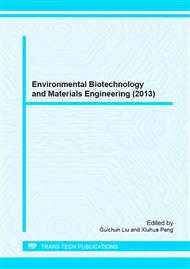p.238
p.242
p.247
p.253
p.258
p.263
p.268
p.274
p.280
Comparative Bioremediation of Oil Contaminated Soil by Natural Attenuation, Biostimulation and Bioaugmentation
Abstract:
In most field studies, enhancing biodegradation of petroleum hydrocarbons depends on the specific microbial population present. It is a dispute whether inoculation microbial consortium improved the degradation of petroleum because indigenous microorganism can easily adapt to surroundings and contend for inoculation microbial consortium. Therefore, all of three technologies (natural attenuation, biostimulation and bioaugmentation) were evaluated. After 8 weeks of bioremediation, it was observed that bioaugmentation most effectively removed 53% of oil under inoculation condition. Poor oil removal of below 4% was observed under natural attenuation without inoculation. In addition, it was found that the degradation of oil in oil-polluted soil followed second-order model and acquired the dynamics equations. The half-life of natural attenuation, biostimulation and bioaugmentation was 833 days, 75days, 25days, respectively. The results indicated bioaugmentation could improve efficiently the degradation of TPH and shorten the bioremediation period.
Info:
Periodical:
Pages:
258-262
Citation:
Online since:
September 2013
Authors:
Price:
Сopyright:
© 2013 Trans Tech Publications Ltd. All Rights Reserved
Share:
Citation:


